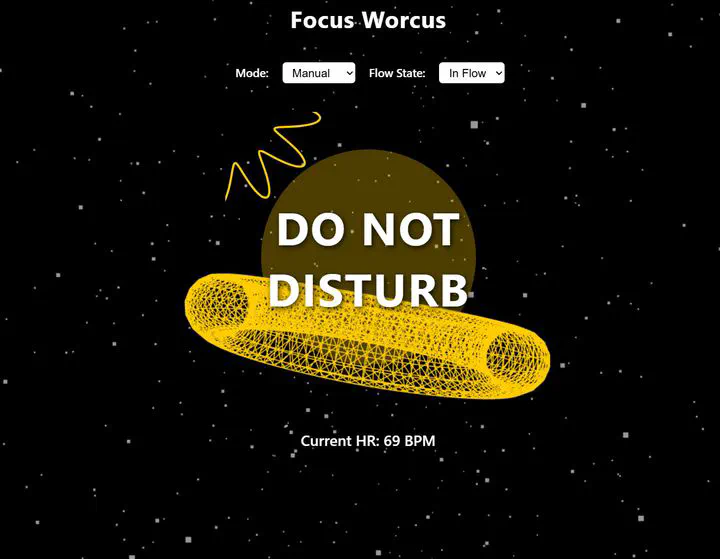Focus_worcus

Focus Worcus: Visualizing Flow State to Enhance Workplace Productivity
In the modern workplace, achieving sustained productivity amidst constant disruptions remains a significant challenge. The concept of Flow State, introduced by psychologist Mihály Csíkszentmihályi, refers to a psychological condition marked by complete immersion, heightened focus, and intrinsic enjoyment during task performance [1]. When an individual achieves flow, productivity naturally increases, creating optimal conditions for creativity and performance [2]. However, maintaining this state demands minimizing frequent interruptions, a common obstacle in today’s workplace.
Understanding Flow State and Productivity
Flow state arises when there is a harmonious balance between the perceived challenges of a task and the skills possessed by an individual. Key characteristics include deep concentration, effortless engagement, reduced self-consciousness, and altered perceptions of time [1][3]. From a workplace perspective, achieving flow has been associated with higher job satisfaction, better performance, and increased overall productivity [4]. Csíkszentmihályi’s model emphasizes that achieving flow depends on aligning the challenge level of tasks with individual skill levels, making it vital for organizations to structure tasks accordingly [1].
Impact of Workplace Disruptions
Despite the benefits of flow states, workplace disruptions significantly undermine their occurrence. Research indicates frequent interruptions drastically reduce the quality and quantity of productivity, causing elevated stress, cognitive overload, and increased error rates [5]. On average, individuals require approximately 23 minutes to fully regain focus after an interruption, which substantially impacts efficiency and effectiveness over time [5]. Therefore, understanding and managing workplace interruptions is critical for fostering optimal productivity.
Technological Solutions: Real-time Flow Visualization
To address these challenges, the “Focus Worcus” website has been developed, providing a real-time visualization of physiological indicators correlated with flow states and overall well-being. This solution employs technology to clearly communicate users’ state of flow, reducing interruptions and enhancing productivity.
Flowchart of the Proposed Tech Stack:
Tech Stack Explained:
- Data Collection: Physiological data from wearable sensors, capturing heart rate and heart rate variability (HRV).
- Data Transmission: Secure wireless protocols transmit data in real-time to cloud storage.
- Backend & Storage (Firebase): Firebase offers robust and scalable real-time data handling, enabling seamless integration of backend processes.
- Processing and Analysis: Firebase Cloud Functions automate processing, identifying physiological indicators of flow states, recovery, or stress.
- Frontend Development: Utilizes React.js, with interactive visualizations powered by libraries such as D3.js or Chart.js to ensure intuitive, engaging, and dynamic representations.
- Hosting: GitHub Pages provides free static hosting, linking seamlessly with Firebase’s real-time backend infrastructure.
Enhancing Team Productivity: Visualizing “Do Not Disturb”
A key feature of the Flow State Visualizer is the real-time “Do Not Disturb” indicator. Clear visual signals—such as color-coding (e.g., green, amber, red), or ambient icons—serve as an intuitive method to inform colleagues of one’s current flow state [6]. Such visual indicators help mitigate unnecessary interruptions, allowing deeper engagement and more efficient use of working hours.
Historical Data Reflection
The system also includes the capacity for analyzing historical physiological data, providing users with insights into their productivity patterns across daily, weekly, and custom-defined intervals. Reviewing historical flow and heart rate data empowers individuals to identify trends, recognize triggers, and optimize their routines to achieve more consistent flow states [7]. This reflection not only supports productivity but also encourages mindful self-management practices, contributing to long-term workplace satisfaction and personal growth.
Conclusion
The integration of psychological insights, real-time physiological monitoring, and effective technological infrastructure provides a robust solution to enhance productivity and reduce workplace disruptions. The Flow State Visualizer demonstrates the potential of personalized, data-driven feedback systems, fostering environments conducive to sustained focus, high performance, and holistic well-being.
References
- Csíkszentmihályi, M. (1990). Flow: The Psychology of Optimal Experience. Harper & Row.
- Peifer, C., & Engeser, S. (2021). Advances in Flow Research. Springer.
- Nakamura, J., & Csikszentmihalyi, M. (2014). The concept of flow. Flow and the Foundations of Positive Psychology, 239-263.
- Jackson, S. A., & Eklund, R. C. (2004). Flow in sports. Human Kinetics.
- Mark, G., Gudith, D., & Klocke, U. (2008). The cost of interrupted work: More speed and stress. Proceedings of the SIGCHI Conference on Human Factors in Computing Systems, 107-110.
- Matthews, T., Rattenbury, T., & Carter, S. (2007). Defining, designing, and evaluating peripheral displays: An analysis using activity theory. Human-Computer Interaction, 22(1-2), 221-261.
The “Flow State Visualizer” represents an innovative intersection of psychological theory and practical technological applications, laying the groundwork for improved personal productivity and workplace harmony through mindful communication of focus states.